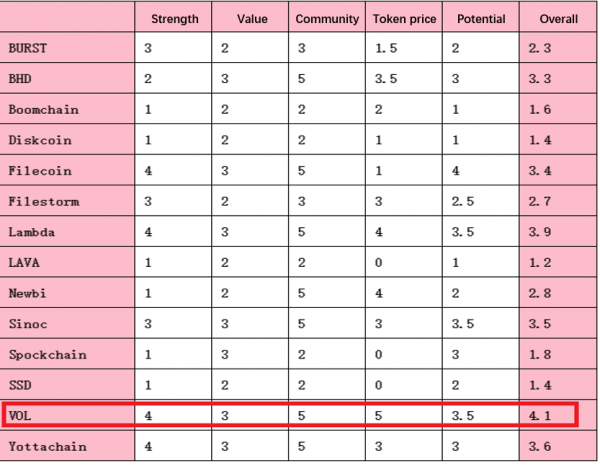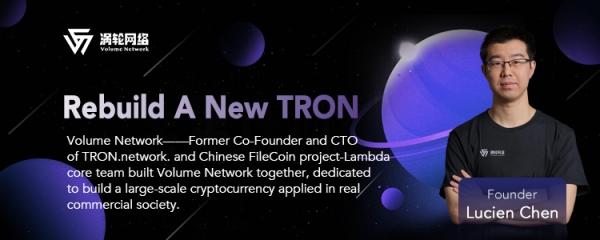In 2008, Satoshi Nakamoto proposed the idea of Bitcoin and published the open-source software of Bitcoin in 2009. Bitcoin’s journey from 0 to 1 is full of twists and turns, ups and downs, and in a blink of eye, it has been 10 years. However, for the majority, Bitcoin appears to be an exclusive club whose door is only open to a few.
In 2019, former CTO of Tron, Lucien Chen started a project called Volume in the hope of guiding more people into the world of digital currency. The project generates a new digital currency VOL via the encrypted consensus algorithm by hard disk capacity. VOL is a currency like Bitcoin, but it is not a common public chain project, nor an application project. To some extent, VOL can be seen as the BTC of the hard disk mining industry.
When compared to all hit hard disk mining project, VOL had a better point than the recent hit projects Lambda and BHD, sitting at the top of the chart with the best overall performance.

What improvements has VOL made based on BTC?
VOL, the Volume Network, uses an encrypted algorithm related to hard disk capacity to guarantee the production of the currency. Similar to Bitcoin that uses an encrypted algorithm related to computing capacity, the circulation of the currency is fair and square; the difference is that instead of calculating the random number from the entire network like BTC does, VOL searches for that number in hard disks of the network. Compared with BTC, VOL stands out with its own edges:
- Eco-friendlier mining: As we all know, BTC mining has been categorized as outdated production capacity due to its huge electricity consumption. By comparison, the POST hard disk mining mechanism of VOL does not consume massive amount of electricity, which not only avoids energy waste but also makes it convenient for users to mine at home. In addition, the life span of hard disk exceeds that of ASIC chip and GPU used by BTC, which means that you don’t have to frequently update your devices.
- Naturally anti-centralized: As BTC mining evolves from CPU to GPU to FPGA, the devices become more professional and the computing power becomes more centralized; yet the hard disk mining of VOL is naturally anti-centralized.
- Lower threshold: The VOL network is just at a starting point with its hard disk mining mechanism, which allows for mining with simply a household computer; while with BTC, you will be looking at thousands or even millions worth of investment! With VOL, it costs far less than BTC to mine, be it the earlier or the later stage of your investment.
- Lower risks: The general blockchain market remains unstable. If another bearish market hits, many mines will crash and the mining machines of BTC will just turn into worthless pieces of metal. With the hard disk mining mechanism, even if the hard disk is not used for mining, it can still be used for household computers.
- More robust economic model: To incentivize early adopters, Satoshi designed the halving mechanism of Bitcoin: the block reward halves every 210,000 blocks. In 2020, the reward will be halved down to 6.25 BTC. When you look at VOL, with a dynamic token producing mechanism, VOL’s economic model prevents problems like high threshold for the latecomers and centralized mining capacity, making it possible for enhanced decentralization and user participation.
- Healthier and more secure management of VOL mining pool: For BTC, the mining pool which distribute all the profits to each miner in a centralized way, which is very likely to be a non-transparent and unfair process. With VOL, miners sign to join the Mining Pool Representative Nodes (MPRN), and the mining pool does not hold the private key of the miners. Pledges are made on the chain to MPRNs, and the profits will be automatically distributed, guaranteeing the benefits of the miners in a highly secure way.
Lucien believes that VOL is still at its infancy, and the team is patiently welcoming more participants to its ecosystem. The team is confident that one day when a “consensus” is reached of VOL, it will become a basic currency just like BTC. Even BTC was unknown 10 years ago. Lucien and the team is very confident about the future of VOL.
What improvements can we expect from VOL compared to BHD?
Technically speaking, BURST is the originator of hard disk mining. The random number is written into the hard disk by Plotting, and miners search for and broadcast the best-matched random number in the hard disk based on the hash of the block as it is generated. The network will select the best-broadcasted random number and reward its miner. Therefore, the more capacity the hard disk has, the more random numbers can be written by Plotting, and the greater the computing power can be.
In the field of hard disk mining, BHD is a good representative. It is an early project developed by a completely anonymous team. As the former co-founder and CTO of Tron, Lucien Chen has extensive experience in blockchain and distributed computation. Although VOL is a latecomer in the field, it manages to make substantial progress in terms of consensus mechanism, economic model, token distribution model and technical strength.
VOL uses a safer consensus mechanism
First, on the consensus level, BHD uses the PoC algorithm. Each block will be bound with an exclusive “puzzle”. Before the mining starts, the network will store the solutions to the “puzzle” in your hard disk, which is called Plotting. Differently, VOL uses the PoST algorithm, introducing the temporal operator on top of the spatial proof algorithm. By using the features of VDF, miners are required to conduct mathematical calculations for a certain period of time after they obtain data of the potential blocks, and then they will have to choose the block based on these data and results that can be quickly verified.
If you read through documentations about PoST and PoC, you can see that PoST clearly has advantages over PoC in the following aspects:
- PoC suffers from vulnerabilities such as selfish mining and rewriting attacks, while PoST does not.
- PoST is more expandable in terms of subsequent use of the hard disk. Users can store their personal files like videos and music in a PoST hard disk, yet PoC can only be used for storing hash values of the mining.
VOL owns a more robust economic model
BHD and VOL both use the “pledge mining” mechanism.
BHD uses a “fixed” pledging mechanism where the computing power/TB is pledged for 3 BHD; if fewer than 3 BHD, the miner can only get 30% of the block reward, and the rest 70% will be allocated into the foundation address. This is risky because nobody knows who controls the foundation address.
VOL uses a “dynamic” pledging mechanism where the computing power/TB is pledged for 300 – 1,200 VOL. If it’s less than 300 VOL, the miner will not get any block reward; if it’s no less than 1,200 VOL, then the miner will get the maximum amount of block reward; if the pledging amount is between 200 and 1,200 VOL, then the reward will be less than the maximum amount.
Based on the official rules published by the VOL team, you will not get the maximum amount of block reward if you do not meet the minimum/maximum pledging requirements, and your token balance will not be allocated into the unknown foundation like BHD. In this way, the release of the tokens is controlled at a solid pace and the profits of the miners are well guaranteed.
In addition, VOL is more thoughtful when designing the economic model, focusing on two factors:
- Deflation model. According to the official rules, the maximum VOL release amount will be lower than the maximum locked amount. The release amount of each year depends on the pledged amount of the network, which is dynamic.
- Exquisite design of the pledging minimum/maximum. You will see that the additional amount pledged above the minimum will generate an annual return of a quarter of itself, which equals a 25% annualized return.
VOL employs a fairer token allocation model
The circulation of BHD is 21 million, of which the developing team takes 2.1 million (10% pre-mining), the marketing team takes 1.05 million (5% production from mining), and 17.85 million are available for mining (an 85% supply for miners).
The circulation of VOL is 10 billion, of which 3% (of $30,000 worth) is used for IEO, and there is a 97% supply for the miners.
It’s uncertain if the 10% taken by the developing team will affect the development of BHD itself, but the VOL team has shown its sincerity by using 3% of their circulation which is worth $30,000 for IEO.
Lucien Chen hopes that by “airdropping” to VOL holders, they can grow together with the project. A 97% VOL supply for mining indicates no risks of selling. It appears that VOL has a more reasonable token allocation model.
VOL is armed with greater technical strength
Lucien Chen, founder of VOL, the first employee and former CTO of Tron,had led the implementation of Tron’s public chain with an application ecosystem. Prior to Tron, Lucien worked at a high level at Internet giants such as NetEase Youdao, Tencent, Qihoo 360 and Alibaba, accumulating extensive experience in AI, recommendation system, distributed system and other technical areas. He’s also an expert in developing system framework. In addition, as an early supporter and investor in Bitcoin, Lucien has profound understanding of cryptology.

Lucien’s VOL team will make the main net code and all its products (browser, wallet) open source on GitHub by the end of this year. Moreover, VOL’s collaboration with Lambda, the “super dark horse” of blockchain storage puts the technical icing on the VOL cake. In the future, VOL users can also expect an integration with Lambda that allows dynamic interactions between the two networks.
No comments on BHD which has no known technical assistance, nor news about open source. The only thing we know is that BHD’s white paper claims that they will “conduct open source after internal adjustments” at an indefinite time.
Last but not the least, BHD uses a “centralized” wallet to implement pledging by depositing BHD in the wallet. VOL, on the contrary, puts all the pledges on the chain, which can be searched in the browser. The pledge cannot be withdrawn until 2 weeks after it’s released. By comparison, BHD risks selling when miners exit yet VOL does not because of the 2-week time frame.
Lucien Chen’s vision for VOL: a “basic currency” like BTC
Statistics show that by the end of Q1, 2019, mining digital currencies account for 68% of the general digital currency market. The mainstream projects are those based on the PoW consensus mechanism, and these projects are all faced with problems such as high energy consumption, centralized computing power and scaling challenges, making it harder and harder to see the future of BTC and other PoW-based tokens; other projects like ETH and GRIN are shied away from being mainstream options due to their high GPU costs. On that note, a project that is based on hard disk mining is one that truly has low threshold.
Lucien Chen has his vision set for VOL: a “basic currency” like BTC, and the team is setting sail for an ambitious journey of integrity and intelligence.
Website: https://volumenetwork.io
Twitter: https://twitter.com/network_volume
Official Telegram: https://t.me/VolumeNetworkio
Media Contact
Company Name: VOLUME NETWORK FOUNDATION LTD.
Contact Person: JAN
Email: Send Email
Country: United States
Website: http://www.globalnewsonline.info/

